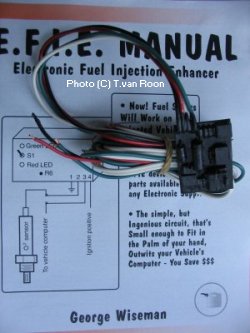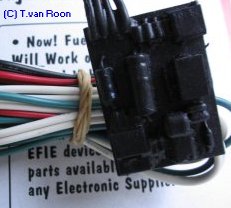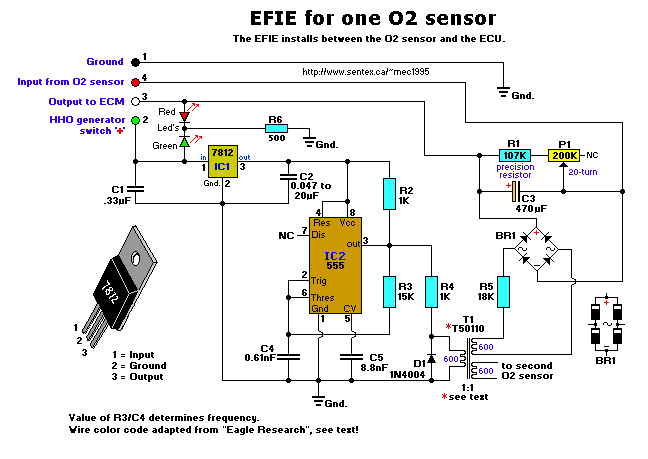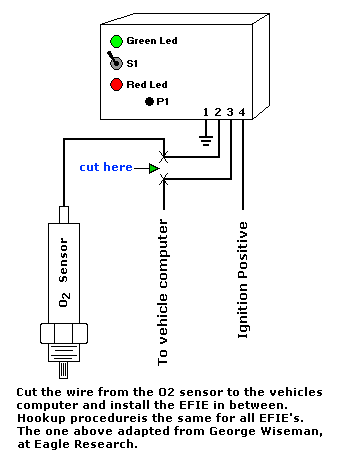
The "E.F.I.E."
E.F.I.E. stands for Electronic Fuel Injection Enhancer (pronounced Ee-Fy). It is an ingenious
small device which talks to your car's computer, or ECU for short. Like the title indicates, it is only for vehicles
with fuel injection. A vehicle with a carburetor does NOT need an EFIE.
An EFIE by itself is not really a fuel saver, although if used alone can save 5% - 10% on your fuel bill, simply by
'leaning-out' your fuel mixture. Although presently it is one of the greatest inventions of our time in regards to
fuel-savers in recent history. The EFIE allows fuel savers to operate on any fuel injected engine. "Then why
haven't I heard about it..." you ask? I'll let you figure that one out for yourself. THINK!
Most modern car fuel injection systems work with an oxygen sensor to control the air:fuel ratio of the engine. With
the EFIE used alone without a combustion enhance like hydrogen, a fuel savings of up to 5-15% can be obtained
depending on your engine, ECU type, your adjustments, etc.
Adding a Hydrogen-Booster in combination with an EFIE can really make a difference, some are listed to save up to 75%
or better. Even if you purchased your EFIE instead of making one, you have your investment back in a couple fill-ups.
If you're normally get, say 450KM out of a full tank of gas, a minimal 15% gives you a range of 517KM. That is a good
67KM extra. If you gas up twice a week that's an extra 134KM! And even in this worst case scenario, so worth it.
I believe in patent-free technology and information and so everything on this website in regards to a EFIE, Hydrogen
Booster, Hydroxy something schematic diagram, or whatever, will be free. Take it, print it, copy and share it, have
fun, save fuel, and help to preserve our environment with a cleaner exhaust.
The particular model schematic diagram listed here will work on Fuel Injected vehicles. It works with any fuel:
diesel, gasoline, natural-gas, propane, methanol, and others too.
 Eagle Research is one of the best known on
the web and my own first EFIE was purchased from them. Beautifully dipped in soft rubber type material to make it
waterproof. Wires on the device are about six feet long so thats plenty. They did an excellent job and I can recommend
it to anyone.
Eagle Research is one of the best known on
the web and my own first EFIE was purchased from them. Beautifully dipped in soft rubber type material to make it
waterproof. Wires on the device are about six feet long so thats plenty. They did an excellent job and I can recommend
it to anyone.
Why buy one if you can make one yourself? Well, as I mentioned before I want to do my own testing and so I needed a
working EFIE with tested specifications. I also wanted to see how much their version differs from other circuit
diagrams available on the web for free. I noticed different resistor/capacitor values and the special 1:1 ratio transformer from Rhombus Industries,
and a nicely done printed circuit board. Another nice feature of the unit from Eagle Research is that you can purchase
the 'E.F.I.E. Manual' with everything you wanted to know, schematic diagram, options, etc. all for an extra $6.00. I
must say it is worth every penny! Eagle Research has also further developed the device and you can purchase an
assembled and wired EFIE unit from them directly. They have their hands full and are incredibly busy, so it may take
up to 8 weeks or so to get it mailed out to you. Check out the link and I'm sure you will be impressed.
 Using an EFIE in combination with a Hydroxy-booster increases the savings significantly. The water-vapors not only boosts
the octane level, it also keeps the engine clean of carbon deposits. And no, Hydroxy or Hydrogen boosters will not rust
your engine. That's one of the many myth created by those affiliated with the oil industry. No surprise there, we've
all seen and heard it before. They want you to keep using as much fuel as possible!
Using an EFIE in combination with a Hydroxy-booster increases the savings significantly. The water-vapors not only boosts
the octane level, it also keeps the engine clean of carbon deposits. And no, Hydroxy or Hydrogen boosters will not rust
your engine. That's one of the many myth created by those affiliated with the oil industry. No surprise there, we've
all seen and heard it before. They want you to keep using as much fuel as possible!
Alright, on with it. The oxygen sensor tells the ECU if the air:fuel is lean, just right, or rich. If it is lean or
rich the ECU will simply increase or decrease fuel to maintain the 14.7:1 air/fuel ratio, if it is 'just right' it means
that 500 millivolts is equal to the 14.7:1 air:fuel ratio. The voltage of the O2 sensor can go up as much as 1.9VDC
and as low as -2VDC on some vehicles.

EFIE Parts List:
R1 = 107K C1 = 0.33uF
R2,R4 = 1K C2 = 0.047 to 20uF
R3 = 15K C3 = 470uF, 35V, electrolytic
R5 = 18K C4 = 0.61nF
R6 = 500 ohm (Optional) C5 = 8.8nF
P1 = 200K, 20-turn trimmer pot.
IC1 = 7812 volt regulator, TO-220, no coolrib required
IC2 = 555 Timer IC, 8-pin dip
D1 = 1N400x, general purpose diode. Any in the series will do (1N4001-1N4007)
BR1 = Bridge Rectifier, 100/5A, or make from 4 1N4004 diodes (see insert)
T1 = T50110, Rhombus Industries
Led = 1 green, 1 red. (Optional)
Oxygen sensors can be found in most modern vehicles (in the exhaust), either with a carburetor or fuel-injection.
The oxygen sensor will communicate with your vehicle's computer (ECM) to regulate the air/fuel mixture ratio, which is
about 14.7 to 1. The vehicle's computer will use that information from the O2 sensor to determine if more or less
gasoline should be added to the mixture to attempt to maintain the correct ratio.
More or less fuel will be added by the computer when the O2 sensor detects the amount of oxygen in the exhaust.
You see the problem when you try to change this scenario with a fuel efficiency device of any kind for any given
air/fuel ratio. There will be more oxygen in the exhaust when a fuel efficiency device is installed and the computer
will automatically add more fuel. The solution is simple. Adjust the signal coming from the oxygen sensor to compensate
for the increased fuel efficiency. An electronic device is needed to negotiate with the computer and the oxygen sensor.
Such a device is called an EFIE and can be build easily and cheaply.
 How to install the EFIE and set it up:
How to install the EFIE and set it up:
The wire colors and wire numbers are compatible with the ones specified by Eagle-Research. I decided to implement
those colors and not confuse a possible builder with all sorts of different colors. So, here are the official colors,
as used by Eagle-Research:
Wire #1, to ground, black
Wire #2, to O2 sensor, green
Wire #3, to car computer, white
Wire #4, to ignition positive, red
The black wire from the EFIE goes to vehicle ground or chassis also called 'negative'.
Ensure that the EFIE is grounded very well. You can connect the black wire anywhere onto the chassis. Just make sure
it is negative. To check, put a multimeter in the 'continuity' or 'ohms' setting and measure between the spot you have
selected and the negative at the battery side and make sure it reads about 0-2 ohms or the continuity buzzer is going.
If you measure 'ohms', the reading you get is probably the resistance from probes. Perfectly normal. If you have that
you have a good, solid ground and can connect the black wire.
Connect the red wire to an ignition switched power source (positive), so that the EFIE will shut off when you shut off
the ignition key, usually the fuse-box has spare terminals for this sort of thing. Or tap into any power wire that shuts
off when the ignition key is turned off. The radio positive is one of them connections.
The White and Green wires go to the oxygen sensor output wire down near the oxygen sensor itself.
Connect the White wire from the EFIE to the wire leading to the vehicle's ECU or vehicle's computer
(used to go to the oxygen sensor before you cut it).
Connect the Green wire from the EFIE to the wire leading from the oxygen sensor itself.
Fine-tuning the EFIE:
The trimpot P1 is a 20-turn type trimmer potentiometer. Set it approximately to the center position, e.i. 10 turns.
You can measure that the EFIE is working by checking that you have a voltage between the Green and White wires. Set the
initial voltage with the trimmer pot to about 350 millivolts when the ignition is 'ON' but the engine NOT running.
Then adjust the voltage (turn the trimmer clockwise (lean) or counterclockwise (rich) increasing richness toward normal
as you see fit. Lean-up the engine (by turning the trimpot clockwise) until you observe power loss of the engine, then
rich it up again until you get the power back. Warm up the engine and go for a test drive.
Eagle-Research recommend 25 millivolt increments until you're happy with your settings. I agree with that.
Engine Problems--how to fix:
When you are fine-tuning the EFIE, it is possible you may or may not encounter the following problems:
"Check Engine" light (usually amber) comes on.
It means you over adjusted to 'lean' a bit. Don't worry about it. Just turn down the EFIE a bit and reset your car's
computer (required). You can do that two ways. First, switch off the engine, then turn the ignition 'ON' only,
without the engine running. Keep it in this position for up to 20 minutes or when the light goes off all by itself.
Then start the car as usual. If that doesn't do the trick you have to do a 'cold-reset' by disconnecting
the negative battery cable (with the engine switched off) for a couple minutes. Then reconnect it again the light
will be off. The car computer will not be listening to the oxygen sensor when the computer is in 'limp' caused by the
amber 'Check Engine' light. The fuel mixture will be richer when that light is on, just try to remember that fact.
"Theft System" light (red) comes on.
If the light is on solid, no big deal. There are many causes for this light to come on. Unfortunately none of them have
to do with 'theft' in most cases. Any faulty micro-switch, like the one on your fuel-door for the gas tank, will most
likely trigger this light to "ON" if it is not repaired within a certain time period. If the light is flashing it
means starting the engine is prevented. You can crank the engine but the engine is prevented from 'running'. Again, turn
the EFIE down a bit and turn the ignition key to 'ON' (don't try to start) and leave it on until the light goes off, probably
after 15 to 20 minutes (says the manual but in reality I had to leave it in ignition for as much as 34 minutes). Basically
leave it in the ignition setting until the light goes off, never mind the time it takes. Then turn the ignition to 'off' first
before you start the car. I personally find this feature a real pain-in-the-behind.
Your vehicle's computer will 'learn' by itself the new settings. Just give it time to do so. Some vehicle computers
may take as much as a couple hours to completely adjust, so adjusting the EFIE may take place over several days. In the
end you will be a happy camper!
Links, Files, Data, and Diagrams:
Eagle Research - For practical energy solutions.
EFIE Installation - Alternative Energy Resources
EFIE Fuel-saver manufacturer - FuelSaver MPG
EFIE manual - Another EFIE manual
Another EFIE Schematic Diagram - By ZeroFossilFuel
Mike's EFIE Documents page - From FuelSaver MPG
Adding a Hydrogen (Hydroxy) Booster to your vehicle - by WaterPoweredCar.com
Improved version of the Hydrogen Booster - by WaterPoweredCar.com
For Your Information:
The EFIE will not void your vehicle's warranty. It is against federal law for car manufacturers to void warranty
because the customer installed a after-market device.
Also, a dealership or manufacturer cannot put blame on an after-market device simply for that reason. It is the
manufacturer who has to prove that the after-market device is cause of the problem. Naturally, the vehicle's warranty
does not cover the after-market device in any way or form.
Vehicles with more than one oxygen sensor need an EFIE on each oxygen sensor.
When you are adjusting more than one EFIE device, adjust them all to the same voltage and then experiment with changing
the individual units for the highest efficiency.
You only have to adjust the EFIE once. The EFIE is fully automatic and need no further adjustments if everything
stays the same. If there is a change in or to the fuel system, only then a re-adjustment is required.
If you wish to contact the Eagle-Research company, here is the information you need:
USA/Int'l Canada
Eagle-Research, Inc., Eagle-Research, Inc.,
1306 Main Street, 23 Panorama Ridge Rd.,
Oroville, WA 98844 Box 21017
Penticton, BC - V2A 8K8
Web: Eagle Research
Tech Support: [email protected] (customers only!)
FAX: (250) 492-7480
Do not let ANYONE ever compromise your dream, your freedom, your independence or
your truth!
Back to Main Index Page
Contents Copyright © 2008 - Tony van Roon.
Last Updated: August 18, 2010


 Eagle Research is one of the best known on
the web and my own first EFIE was purchased from them. Beautifully dipped in soft rubber type material to make it
waterproof. Wires on the device are about six feet long so thats plenty. They did an excellent job and I can recommend
it to anyone.
Eagle Research is one of the best known on
the web and my own first EFIE was purchased from them. Beautifully dipped in soft rubber type material to make it
waterproof. Wires on the device are about six feet long so thats plenty. They did an excellent job and I can recommend
it to anyone. Using an EFIE in combination with a Hydroxy-booster increases the savings significantly. The water-vapors not only boosts
the octane level, it also keeps the engine clean of carbon deposits. And no, Hydroxy or Hydrogen boosters will not rust
your engine. That's one of the many myth created by those affiliated with the oil industry. No surprise there, we've
all seen and heard it before. They want you to keep using as much fuel as possible!
Using an EFIE in combination with a Hydroxy-booster increases the savings significantly. The water-vapors not only boosts
the octane level, it also keeps the engine clean of carbon deposits. And no, Hydroxy or Hydrogen boosters will not rust
your engine. That's one of the many myth created by those affiliated with the oil industry. No surprise there, we've
all seen and heard it before. They want you to keep using as much fuel as possible!
 How to install the EFIE and set it up:
How to install the EFIE and set it up: